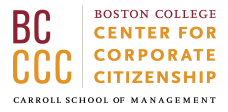WEBINAR: Re-watch this webinar for a look at BCCCC's updated longitudinal study, exploring how corporate citizenship efforts contribute to business objectives including attracting and retaining customers and the development of innovative new products.
Investing in Sustainability: Much More & Not Enough
- Aug 3, 2015
- Graham Sinclair
 Trillions of dollars are invested in sustainability. But trillions are not. What gives?
Trillions of dollars are invested in sustainability. But trillions are not. What gives?
This year's International Corporate Citizenship Conference demonstrated that good progress has been made for the sustainability investment case, but also that much has not changed in the past decade. Michael Dell, CEO of recently de-listed Dell, described that going private to attract business investors with a longer-term mindset was a strategic, sustainable investment decision.
Meanwhile—during a panel discussion—I, along with Nikki McKean-Wood of the Global Reporting Initiative (GRI), Betty Cremmins of CDP, and Tim Mohin, who represented the Electronic Industry Citizenship Coalition (EICC) and is the director of corporate responsibility at AMD (Nasdaq:AMD), agreed that the proliferation of rating frameworks or index rankings over the years is a trend that will continue.
Below are four takeaways on the state of play in making the investment case for CSR, and the conundrum practitioners in business and investment face in 2015:
- THE (BIG) NUMBERS ARE IN
The market for sustainable investment in the money management industry continues to climb. The tenth report on U.S. Sustainable, Responsible and Impact Investing Trends by US SIF (The Forum for Sustainable and Responsible Investment) finds that U.S.-based socially responsible assets under management almost doubled between 2012 and 2014, from $3.74 trillion to $6.57 trillion. Without a singular definition, “sustainable investment” can generally be said to cover the investment theme that proactively integrates environmental, social, or governance (ESG) factors into investment management. As the Center notes in a recent issue of the Corporate Citizen magazine, more and more investment funds are looking at ESG indicators in the evaluation of companies. Big money is looking at sustainability.
2. DEMAND GROWS, UNEVENLY
The drivers shaping demand include corporate malfeasance that has hurt performance, the risks from showing up in headlines, more effective methods to monitor and communicate bad actions by citizens and NGOs, increased regulations on companies' externalities, and an appetite for different assets uncorrelated with market movements and which explicitly include ESG factors. In practice, though, demand is patchy. More people want to know “what’s inside the box?” of their investment, similar to trends in, say, food or clothing. Professional investors are part of this trend, but it's not universal. While some major companies host dedicated sustainability investor presentations, experience by long time citizenship practitioners like Mohin describe years of investment analyst presentations without any substantive sustainability questions being posed by the investment analysts covering major companies. Big money—from pension funds to high net worth individuals and even hedge funds—are demanding ESG factors be considered (the Principles for Responsible Investment counts signatories with $59 trillion in assets under management globally). But many professional investors still ignore the body of evidence around sustainability and good citizenship.
3. SUPPLY PROLIFERATES (TOO MUCH AND TOO LITTLE)
A decade ago, sparse ESG data was available in investment terminals from vendors like Bloomberg, ThomsonReuters (NYSE:TRI), or Factset (NYSE:FDS). Today, these investment platforms compete to increase the quality and quantity of their ESG coverage, adding regional coverage in frontier markets like Vietnam or Chile and issue coverage like clothing supply chain standards. Sustainability reporting has emerged as a common practice of 21st-century business with 95 percent of the Global 250 companies issuing sustainability reports. Of the 579 respondents in the Center and EY’s joint Value of Sustainability Reporting survey, a majority of their organizations (68 percent) issue a sustainability report. Progress has been made: the GRI and CDP reporting frameworks are cross-linked to make reporting more efficient.
Investors rely on companies to decide which ratings and indexes present the most compelling benchmarking of a company’s performance and future prospects relative to their peers. Investors bet on the future. Ratings and indexes provide more information for investors who are seeking certainty within complexity. Narrowing the definitions while working across specific, accountable, and measurable indexes and ratings is necessary. It all adds up to investors with both too many options, and too few, to assess how companies are performing on sustainability issues. Better companies are able to interpret and explain their sustainable investment case to their audience. If you are navigating the frameworks currently out there, I recommend you consider the Boston College Center for Corporate Citizenship's upcoming course: Corporate Citizenship Frameworks and Standards.
4. BUSINESS LEADERS TAKE NOTICE, ONLY SOME INVEST
According to PwC’s 17th Annual Global CEO Survey, 74 percent of global CEOs say that measuring and reporting total non-financial impacts contributes to long-term success. Within the broader sustainability meta-theme, the impact investing niche continues to grow: $50 billion in 2014 and in J.P. Morgan's view is headed for a $1 trillion assets under management (AuM) market by 2020. More broadly, the $282 billion California Public Employees Retirement System, the U.S.'s largest retirement fund, is now tracking the ESG function of all their fund managers. Investors look forwards. Accountants look backwards. As investors seek advantages on forecasting firm's future performance and the advantages of sustainability management and good corporate citizenship, there will be more—not less—demand for tracking of investment impacts whether that reporting is for the retail or institutional investor. Your firm's 401k may already be doing it.
5. INVESTING AS IF THE FUTURE MATTERS
The future is shaped by our investments today, like the person 20 years ago that plants the oak tree for us to enjoy the shade on a hot summer's day in Boston. Let's define the future we want to see. We can start with answers mapped to established frameworks and indexes, translate this to the Conference of the Parties to the United Nations Framework Convention on Climate Change (COP21) for December 2015 in Paris and the United Nations Sustainable Development Goals (UN SDG 2015) updating in September 2015 in New York. We can help companies present compelling arguments to their current and prospective investors. As sustainability and citizenship specialists we are best placed to make the compelling business case for sustainability, and the investments that opportunity presents.
Live well, share your ideas and do work that matters in 2015.
*for more updates, follow Graham Sinclair on twitter.

